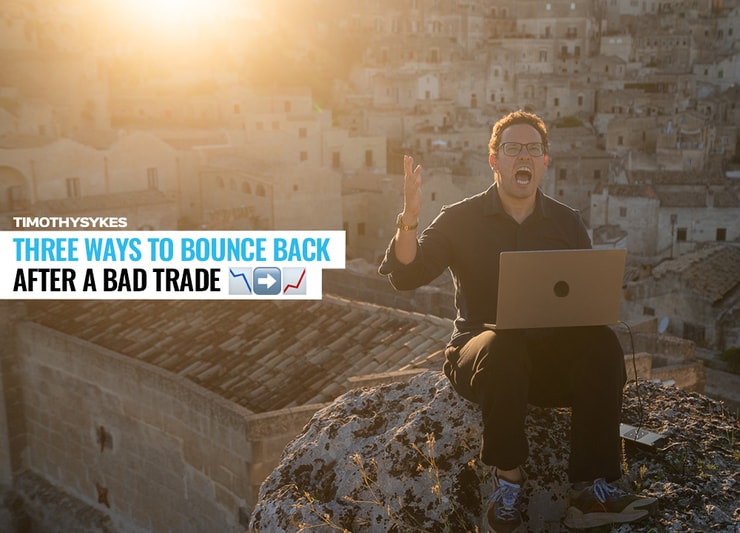Last Tuesday started out great…
I was up nearly $1K trading the ticker symbol WE.
However, I jumped into it a fourth time late in the afternoon and ended up losing a little over $1800.
Ouch.
One bad trade wiped out all my gains for the day.
Mistakes like this might be rare for me, but they offer vital lessons.
The very next day, I nearly made all my losses back.
That said, I know a thing or two about bouncing back from bad trades.
Here are my top three strategies.
Table of Contents
One of The Worst Feelings As A Trader

Very few things feel worse than trading well the whole day and then doing something dumb that ends up ruining your day.
That’s what happened to me on Tuesday. I was up almost $1K in WE, and then I traded it again, and the results were disastrous.
For some traders, a bad trade can lead to them going on tilt, revenge trading, and overtrading.
However, I’ve learned that only brings on bigger problems.
So, let’s talk about how I mentally overcome these bad trades.
Step #1: Own Your Mistakes

So many “traders” on twitter post their massive wins and their big ideas.
If, for whatever reason, they don’t work, they just DELETE…DELETE…DELETE.
That’s why most of them are living a lie.
However, real traders like myself must live with their mistakes.
And while I’ve made $7.5 million in trading profits…I don’t shy away from talking about my losses.
More Breaking News
- Stride Inc. Soars Beyond Expectations With Q1 Earnings: Is It Too Late to Buy?
- Warner Bros. Discovery’s Turbulent Ride: Legal Concerns and Market Shake-Up
- Is TeraWulf Stock Heading for Record Highs?: Breaking Down Its Recent Market Moves
If you don’t acknowledge your mistakes you’re bound to repeat them.
Step 2: Analyze What Went Wrong

In the case of WE, I was playing a panic dip buy. However, it wasn’t at an optimal time.
I constantly review my trades; from that, I know the best time to trade the panic dip buy is at or near the open. And lately within the first 1-2 hours after the open.
However, I took WE late in the afternoon…which I know wasn’t the best time to take it.
But missing the big move earlier, I let FOMO get the best of me.
And because of that, I made a poor decision.
Source: StocksToTrade
In addition, I broke my number one rule: cut losses quickly.
Instead of bailing on the trade when I saw it not working, I added to my position.
Generally a desperate move…and that it was.
It put me in a deeper hole, and I eventually puked the whole thing for a loss of -$1835.
What did I do wrong:
- I traded the setup at a bad time
- I tried to double down instead of cutting losses quickly
- I overtraded the symbol
- My position sizing was too big
Some newbie traders will call themselves unlucky…say the market is rigged…or make up a bunch of excuses.
I don’t.
I try to understand the outcome and take ownership.
Other traders will say stuff like I don’t trade that symbol well, I won’t trade it again. It’s the symbol and not your actions that caused the loss.
I knew I lost because of the actions I took.
I also knew that if I fixed my mistakes, I would make on the next trade, which I did.
Step 3: Review What You Do Best

I want you to take ownership of your mistakes.
But I don’t want you to beat yourself up.
I hate it when traders beat themselves up, and say stuff like I’m stupid, I’ll never get it.…
There’s no place for negative self-talk in trading.
So while it’s important to review what you did wrong in the trade. It’s just as important to analyze your strengths so those are fresh in your mind.
For example, using the following guidelines, I’ve had great success with panic dip buys.
Besides looking for a panic near the open…here’s what else I’m paying attention to:
Don’t worry about whether the company is “good” or not. Lately, the worse the company, the better. I know that sounds crazy, but that’s what happens when shorts forget the principle of supply and demand.
Instead, focus on whether it has a pre-market catalyst or not.
- If it has a catalyst, watch the volume. Ideally, you want to be trading the heavier volume stocks.
- And, of course, it has to be a high-percentage mover. Why? Because shorts think this company doesn’t deserve to be up that much, the more they short, the greater the squeeze.
- Trade these stocks; don’t fall in love with them. For the most part, I’m looking at these stocks as plays. Some have run significantly, but I’m not here to chase. I’m here to make a quick move and be out.
- Follow the momentum. Pick your spots. You don’t have to be in them the whole day or try to HODL.
And you know what?
I got a chance to trade WE yesterday. I saw an opportunity to panic dip buy near the open and took advantage of it.
Source: StocksToTrade
Are You Ready To Level Up?
Trading is not just about executing orders, it’s a whole realm of knowledge, strategy, and fine-tuned intuition.
And as the market evolves, there are always new tactics and perspectives to incorporate into your arsenal.
Remember my trade with the ticker WE yesterday?
Yes, the one that brought in a sweet profit. It’s moments like those, born from dedicated study and expertise, that can elevate your trading game.
However, the biggest pitfall isn’t missing out on a trend, but becoming stagnant in one’s approach. That’s why constant learning and adaptation are key.
It’s about understanding market dynamics, catching patterns before they become obvious, and having the confidence to act decisively.
But here’s the good news: you don’t have to navigate this journey alone.
I’m here to share my insights, experience, and the very strategies that have served me well over the years.
So, are you looking to refine your tactics?
To see the bigger picture and make smarter trades?
Our upcoming live training session is designed just for that. We’ll delve deep into modern strategies, explore recent trades, and most importantly, equip you with actionable insights to take your trading to the next level.
The catch?
There isn’t one. It’s premium knowledge delivered to you in real time without the hefty price tag.
So, are you ready to level up?
[CLICK HERE TO EMBARK ON THE JOURNEY WITH OUR LIVE TRAINING]
Every trading day is an opportunity. Make the most of it. Dive deep, learn more, and level up your game.




Leave a reply